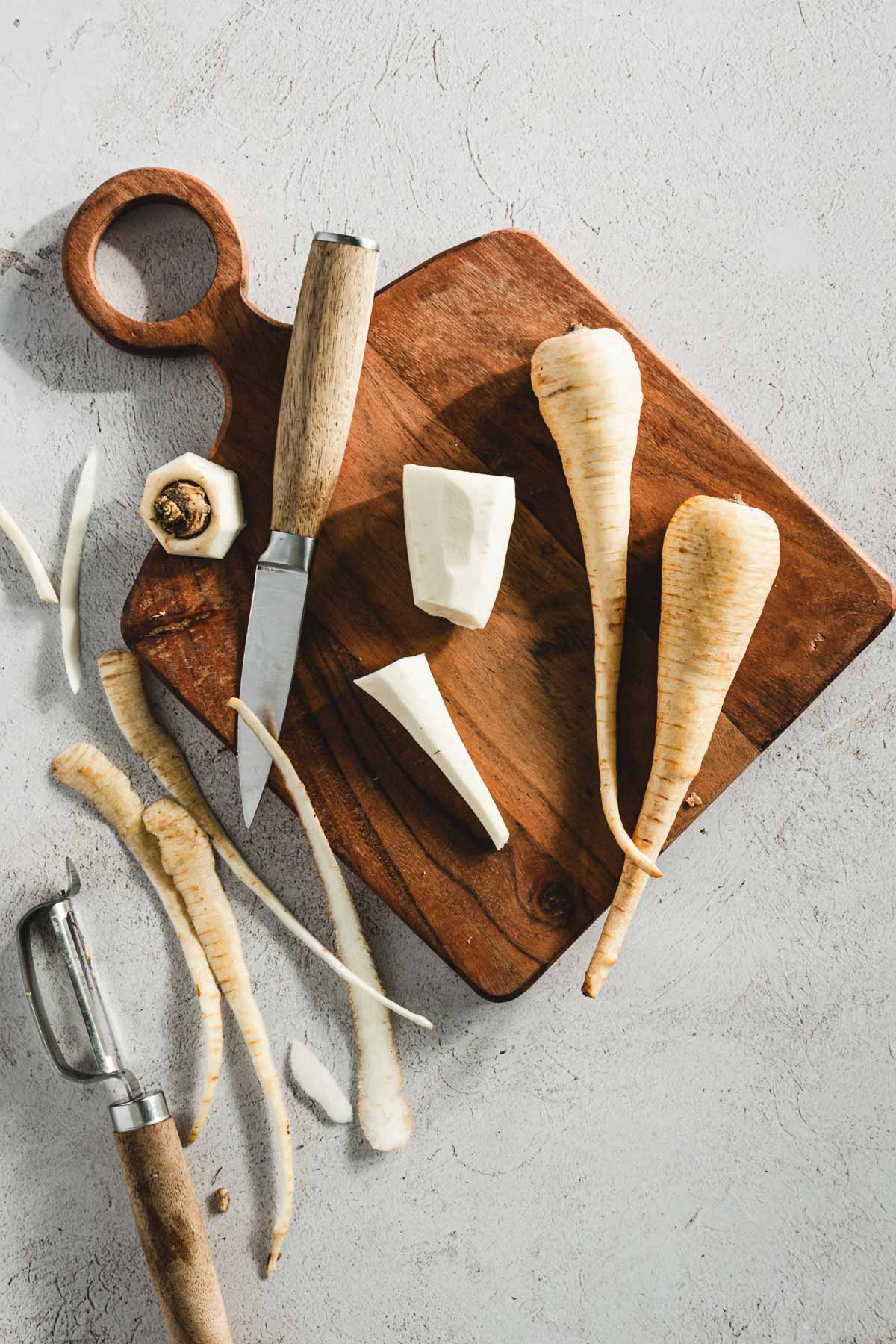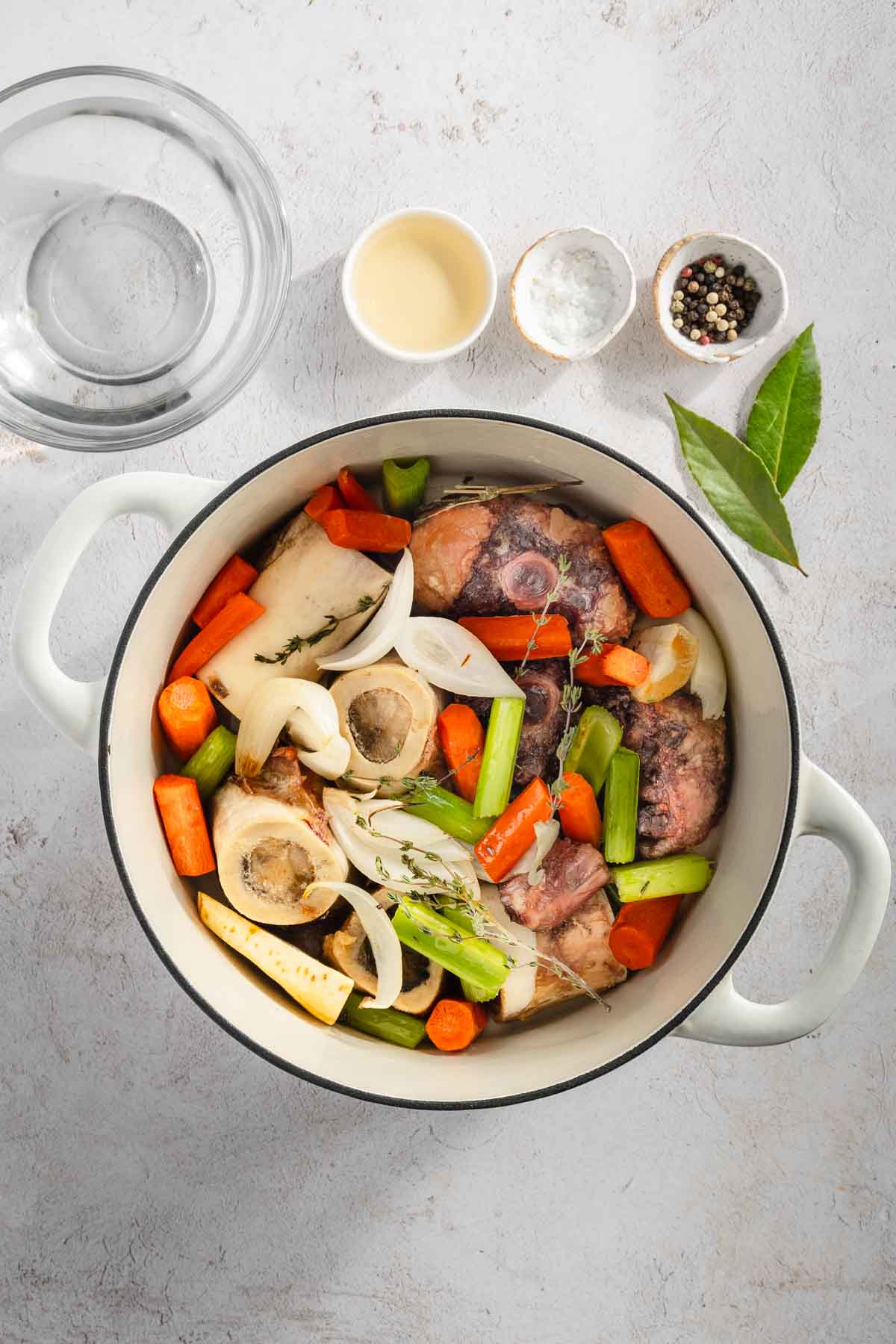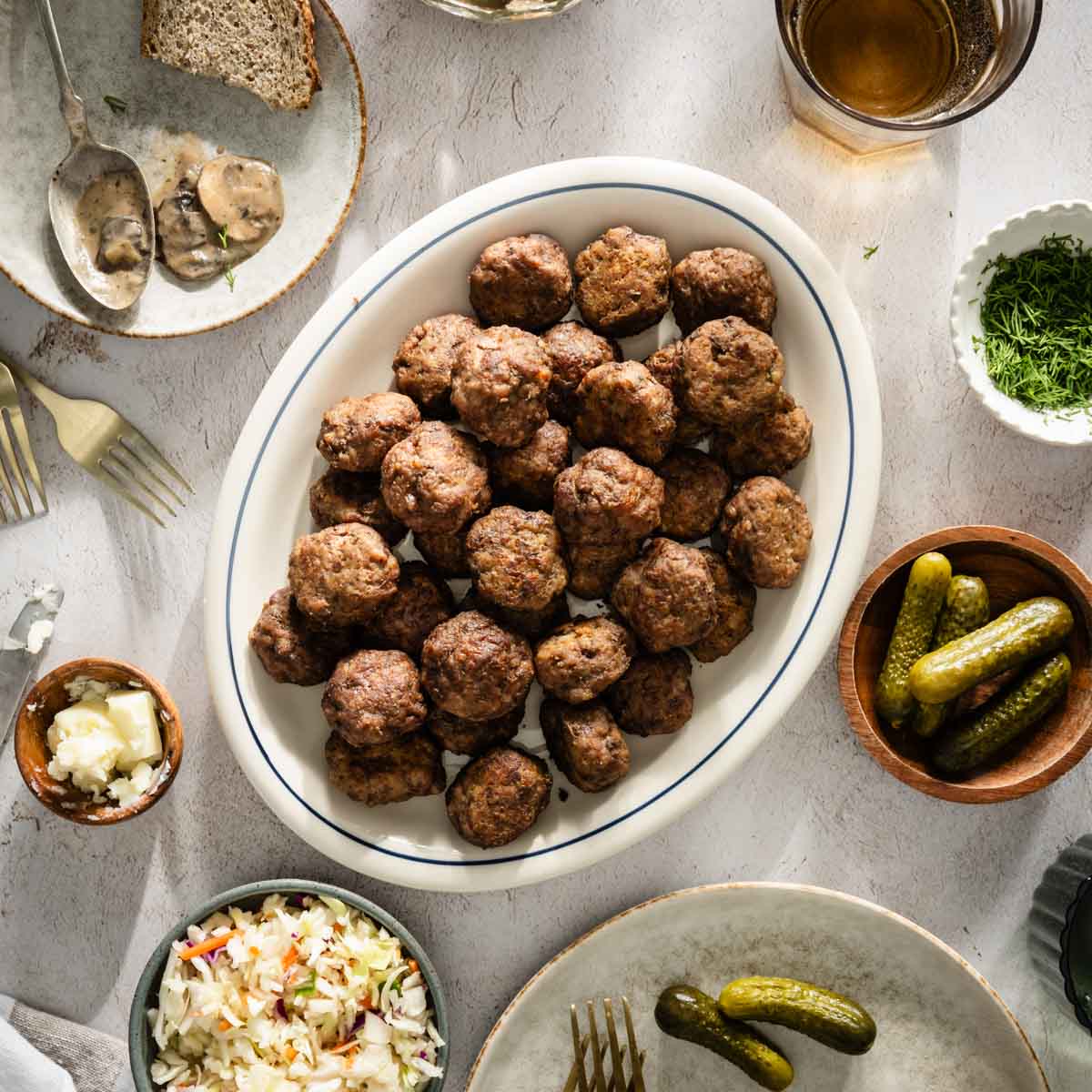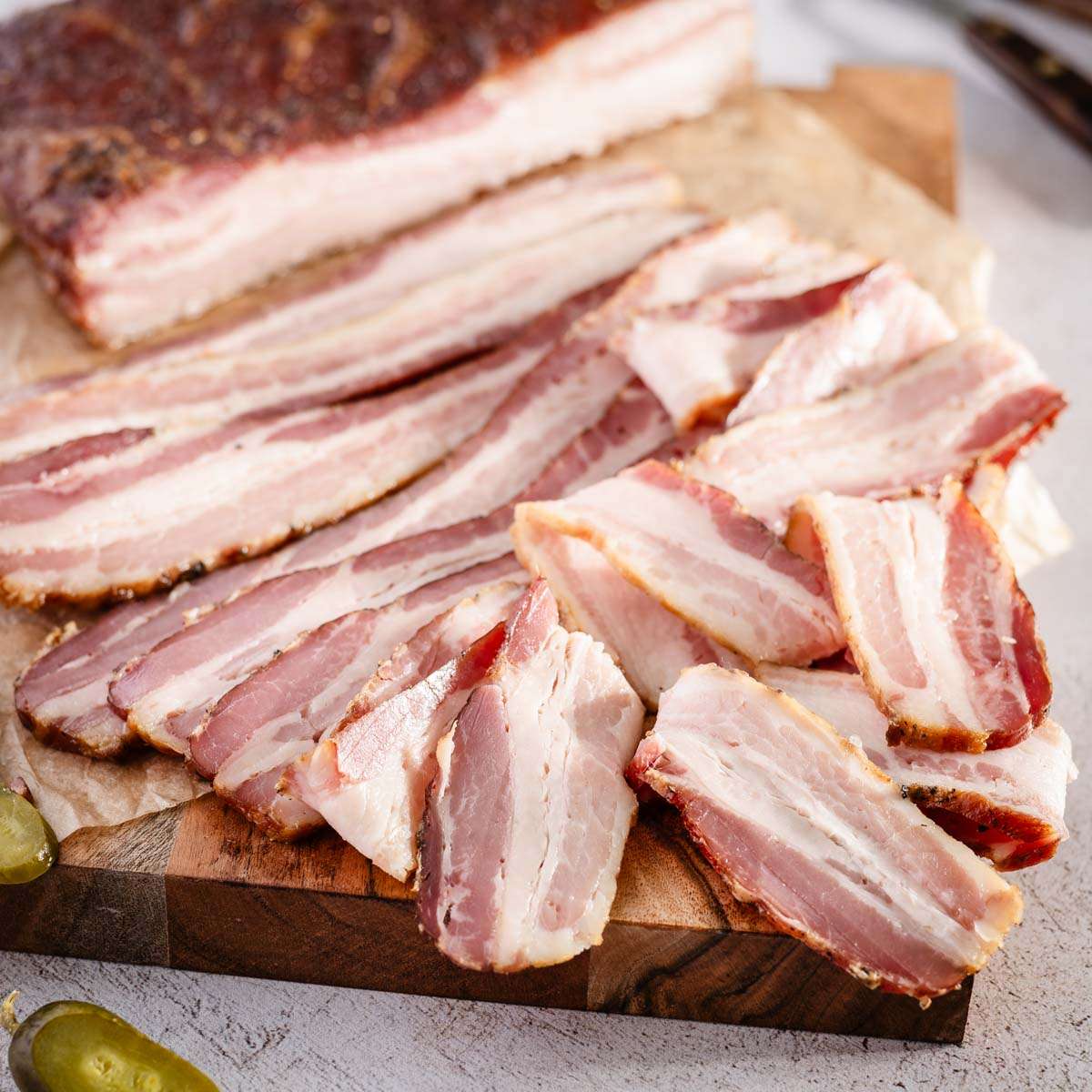Homemade Beef Bone Broth Recipe from the Smoker
Want to know the secret to the best tasting soups, stews or sauces? Use homemade Beef Bone Broth. There are multiple reasons why the Bone Broth is called liquid gold. Yes, it takes a few hours to make but the process itself is very easy. I made mine in the smoker, but using an oven or instant pot will yield great results as well.

Keep reading and you will find more useful tips to make the best tasting Beef Bone Broth. I also share things you should avoid when making broth at home. In essence it all comes down to ingredients, roasting the bones and letting it simmer for a long time.
Why you will love this Beef Bone Broth Recipe
- Flavor – by adjusting the aromatics you can make the broth to your liking; I tend to stick with the basics, but you can experiment with herbs and spices.
- Versatile base – you can sip it as is or use as a base for soups, stews, risotto, sauces or sauté veggies in it, make salsa with it; there are so many options for using homemade bone broth
- Nutritional benefits – packed with vitamins, minerals and collagen; beef bone broth adds a nutritional punch to your diet.
- Reduces waste – Utilizing leftover bones for this broth is an excellent way to minimize kitchen waste. It’s a sustainable choice, transforming something that might otherwise be discarded into a nutritious and delicious base for various dishes.

Why You Should Make Your Own Beef Bone Broth Instead of Buying Premade:
- Full Control Over Ingredients: When you make beef bone broth at home, you have complete control over the quality and type of ingredients used. This means you can choose high-quality beef bones, marrow bones, and fresh herbs to ensure the best flavor and nutritional value.
- Customizable Flavor: Homemade bone broth allows you to adjust the flavor to your liking. Whether it’s roasting the bones for a deeper taste or adding a splash of apple cider vinegar for tanginess. You can tweak the recipe until it’s perfect for your palate.
- No Added Preservatives or Artificial Ingredients: Store-bought broths often contain preservatives and artificial flavorings. By making your beef bone broth at home, you get healthier, more natural product.
- Cost-Effective: Making bone broth at home is more economical. You can use leftover bones from other meals and you can use the bones 2-3 times. Buying bones in bulk can save money in the long run as well.
- Richer Nutritional Profile: Homemade bone broth, simmered for a long time, is rich in nutrients like collagen, minerals, and vitamins. This concentration of nutrients might not be as high in commercial broths due to their shorter cooking times.
- Reduced Waste: Making your own broth is an excellent way to use up bones and vegetable scraps that would otherwise be thrown away, making it an environmentally friendly option.
- Improved Taste: Many people find that homemade bone broth has a richer, more complex flavor compared to store-bought versions. This is often due to the longer cooking time, which allows for a deeper extraction of flavors from the bones and vegetables.
Difference Between Beef Broth and Beef Bone Broth:
While both beef bone broth and beef broth start with bones, the key difference lies in cooking time.
Beef broth has a shorter simmer, resulting in a lighter flavor compared to the robust, gelatinous texture of bone broth.

Ingredients, Variations and Substitutions you need to make Beef Bone Broth
Beef bones – oxtail, marrow, knuckle bones, beef shanks, soup bones; Marrow bones add richness, while knuckle and joint bones contribute collagen for a hearty broth. You can also use chicken bones, like feet, heads or necks. Keep in mind this will not be a beef bone broth anymore.
Celery sticks – adds savory and earthy flavor to the broth; use both stems and leaves. As a substitute you can use fennel



Yellow onion – it offers a sweet and mild flavor to the broth. Use fresh, firm onions with no signs of sprouting or soft spots. You can substitute with white onions or even shallots.
Carrots – add a touch of sweetness and contribute to the broth’s rich color. Opt for fresh, firm carrots with vibrant orange color. Scrub or peel them depending on your preference. Sweet potatoes or butternut squash can be used for a different flavor and color profile.
Parsnips – add sweet and slightly spicy note, enhancing the complexity of the broth. Choose smaller, firm parsnips for a sweeter taste. Peel and trim them before adding to the pot. Turnips or rutabagas can be used for a similar sweet and earthy flavor.
Herbs, thyme, parsley – Thyme contributes earthiness, while parsley adds a fresh, herbaceous note. Use fresh herbs for the best flavor. You can tie them into a bundle with kitchen twine for easy removal later. Rosemary or oregano can be used instead of thyme, and cilantro can replace parsley for a different herbaceous twist.
Bay leaves – impart a subtle, floral aroma and enhance the overall flavor of the broth. If possible use fresh leaves, 1-2 are plentiful. Remove them before serving. Dried thyme or oregano can be used as alternatives for a slightly different flavor.
Peppercorns whole – add a gentle heat and depth to the broth without overpowering. Use whole black peppercorns for a milder heat. Crushing them slightly before adding can release more flavor. White or mixed peppercorns can be used as well. Adjust the quantity based on your spice preference.


Apple cider vinegar – adds a subtle tanginess, helps extract minerals from the bones, and balances the overall flavor. Use unfiltered, raw apple cider vinegar for maximum health benefits. White wine vinegar or red wine vinegar can be used for a different acidity profile.
Top Tip Remember, the key to a great bone broth lies in the quality and freshness of your ingredients
Top Tip: Don’t skip the apple cider vinegar. It is important in the process of drawing nutrients from the bones.
Equipment you will need
- Wood Pellet Smoker, oven, slow cooker, stove top
- Baking sheet
- Parchment paper
- Large heavy bottom cooking pan; Dutch oven
- Measuring cups and spoons
- Cutting board
- Chef’s knife
- Vegetable peeler

Useful Tips for Making Beef Bone Broth:
- Roast the bones – yes, it may seem like an extra step, but the flavor you get in return is so worth it! Caramelizing the bones and meat creates deeper and richer flavor
- Skim, Skim, Skim – Regularly skim off impurities for a clearer broth.
- Balance the Flavors – Adjust salt and spices gradually, tasting as you go.
- Batch and Freeze – Make a big batch and freeze in portions for easy access to a flavor-packed base.
Step by step instructions for beef bone broth from the smoker
- Blanch the bones. Add bones into a pot with water. Bring to boil, simmer for 15 min
- Drain the water, rinse the bones with cold water. This process eliminates the foamy impurities of the bone and meat. Your broth will be clearer if you blanch the bones.
- Place the bones on a baking sheet lined with parchment paper
- Roast in the smoker @450F for 45 minutes. I recommend oak or hickory wood pallets. They complement the beef very well without overpowering.






- Prepare the veggies, wash, peel, cut
- Add celery, carrots, onions and roast together with the bones for another 15 minutes.
- Transfer the roasted veggies and bones into a large stock pot. Add water to cover it all. Add spices and aromatics
- Cook in a smoker set to 350F for approximately 4-6 hours






How To Make Beef Bone Broth In The Oven
To make bone broth in the oven, follow these steps:
- Preheat your oven to 450F.
- Blanch and Roast the bones and veggie as per the instructions in the smoker section.
- Transfer everything to a large oven-safe stock pot. Add water
- Let it simmer in the oven for about 4 hours, allowing the flavors to meld.
- Remove the roasted bones from the oven.
How To Make Beef Bone Broth Using An Instant Pot
To make bone broth in the instant pot, follow these steps:
- Blanch the bones in boiling water for about 15 minutes. Drain, rinse, and pat them dry.
- Use the sauté function of your instant pot to roast the bones for 20 minutes.
- Add veggies, aromatics and water to the cooked bones. Pour enough water to cover the bones and vegetables. Be sure not to exceed the Instant Pot’s maximum fill line.
- Close the Instant Pot lid, ensuring the vent is in the sealing position. Set the Instant Pot to the “Manual” or “Pressure Cook” mode on high pressure.
- Cook for about 3-4 hours for beef bone broth.
- Allow for a natural release of pressure. This can take about 15-20 minutes.
- Once safe to open, strain the broth using a fine-mesh strainer or cheesecloth into a large bowl or pot.
- Allow the broth in the instant pot to cool before transferring it to storage containers. Refrigerate your instant pot bone broth for immediate use or freeze for future use.
Common Mistakes When Making Beef Bone Broth:
- Overlooking Blanching – Skipping the blanching step might lead to a cloudy broth.
- Insufficient Simmer Time – Rushing the simmer can result in a lack of depth and richness. Beef bones are thick and hard, to extract the most of the nutrients, you need to simmer them for a long time.
- Overcrowding the Pot – Too many ingredients can overpower the broth’s subtleties.
- Not including joint bones – Joints have a high collagen density because they have a lot of connective tissue, which breaks down into gelatin creating jiggly broth
- Adding too much water – it will dilute the flavor and benefits of the broth;
Best ways to use Beef Bone Broth
- Base for soups, sauces, stews
- Sip daily for its health benefits
- Add to salsa
- Add to casseroles for more flavor
- Use instead of water for boiling pasta
- Use to simmer or steam veggies using broth
- Poach eggs, chicken, fish or other meat
- Use to deglaze pan
- Perfect to use when making risotto
- Making mashed potatoes – use broth instead of water

You may also like:
Storage instructions
- Cooling Process:
- Allow the bone broth to cool to room temperature before refrigerating or freezing
- Refrigeration:
- transfer to an airtight container once it has cooled to room temperature. Refrigerate promptly to prevent bacterial growth.
- Use within 3-4 days for optimal freshness.
- Do not leave the broth at room temperature for an extended period. Promptly refrigerate any leftovers.
- Freezing:
- Portion the broth into freezer-safe containers. Remember to leave some space at the top to allow for expansion. You can also pour it into ice cube trays for smaller servings.
- Freezer bags: great space-saving option. Pour the cooled broth into heavy-duty freezer bags. Carefully remove excess air before sealing. Lay the bags flat in the freezer for easy stacking.
- use within 6 months to a year for the best quality and taste.
Top Tip: to help track the freshness of the bone broth remember to label all the containers.

Reheating Instructions for Beef Bone Broth
- Thawing:
- Thaw the bone broth in the refrigerator overnight or use the defrost function on your microwave. You can also place the frozen container in a bowl of cold water to speed up the process..
- Stovetop reheating:
- Pour the broth into a saucepan and heat over medium-low heat. Stir occasionally as it reheats. Avoid rapid boiling, as it can impact the flavor and texture.
- Microwave reheating:
- Transfer a portion of the broth to a microwave-safe container. Heat in short intervals, stirring between each, to ensure even heating. Be cautious, as overheating can cause the broth to boil over.
Top Tip: Reheating
- Reheat only the amount you plan to consume. Repeated reheating and cooling can affect the flavor and texture over time.
- Taste the reheated broth and adjust seasoning as needed. Flavors can mellow during storage.
- Avoid boiling the broth. A gentle simmer is sufficient to heat it through.


Homemade Beef Bone Broth Recipe from the smoker
Equipment
- 1 wood pellet smoker stove top, instant pot, slow cooker
- 1 baking sheet
- 1 parchment paper
- 1 heavy bottom stock pot dutch oven
- 1 chef's knife
- 1 cutting board
- 1 vegetable peeler
- 1 measuring cups and spoons
Ingredients
- 4 lb beef bones oxtail, marrow bones, shanks
- 4-5 celery sticks, chopped sub: fennel
- 1 onion, quartered sub: shallots
- 3-4 carrots, chopped sub: sweet potato, butternut
- 2 parsnips sub: turnips or rutabaga
- 1 herbs, thyme, parsley sub: rosemary, cilantro, oregano
- 2 bay leaves sub: dried oregano
- 1 tsp whole peppercorns
- 3 tbsp apple cider vinegar sub: white or red wine vinegar
- 6-8 cups water
Instructions
- Blanch the bones. Add bones into a pot with water. Bring to boil, simmer for 15 min
- Drain the water, rinse the bones with cold water.
- Place the bones on a baking sheet lined with parchment paper.
- Roast in the smoker @450F for 45 minutes. I recommend oak or hickory wood pallets.
- Prepare the veggies, wash, peel, cut.
- Add celery, carrots, onions and roast together with the bones for another 15 minutes
- Transfer the roasted veggies and bones into a large stock pot. Add water to cover it all. Add spices and aromatics.
- Cook in a smoker set to 350F for approximately 4 -6 hours
Notes
Nutrition
Did you make this recipe?
Tag me @sylwiavaclavekphotography or tag me using #myomnikitchen so I can see your creations! You can also leave a comment below!

Conclusion
I hope the length of making homemade Beef Bone Broth did not scare you. After the initial blanching and roasting it is set it and forget cook. Best part, you can use this broth in so many dishes. By the time you know it, you will be making another batch of your very own bone broth!
FAQ about Beef Bone Broth
What’s the difference between bone broth and regular broth?
Bone broth is simmered for a more extended period, extracting more nutrients and creating a richer flavor compared to traditional broth.
Are there specific bones I should use for beef bone broth?
Marrow bones, knuckle bones, and joint bones are excellent choices. They contain collagen, minerals, and marrow, enhancing the nutritional profile. Click HERE to read more about recommended ingredients.
How long should I simmer beef bone broth?
A good rule of thumb is a minimum of 4 hours, but many prefer a longer simmer, even up to 24 hours, to maximize nutrient extraction.
Can I make beef bone broth in a slow cooker or Instant Pot?
Yes! Both are convenient options. Slow cookers can go for 8-24 hours, while the Instant Pot significantly reduces cooking time to 2-3 hours.
What are the health benefits of consuming beef bone broth?
Beef bone broth is known to support joint health, improve digestion, boost the immune system, and provide essential nutrients like collagen, gelatin, and minerals.
Can I drink beef bone broth every day?
Absolutely! Many people incorporate a cup of bone broth into their daily routine for its health benefits and delicious flavor.
Do I need to blanch bones before making beef bone broth?
Blanching bones helps remove impurities and results in a clearer broth. It’s an optional but recommended step for a cleaner flavor.
Can I freeze bone broth?
Yes, bone broth freezes well. Portion it into containers or ice cube trays for easy use in cooking or sipping. Find more instructions in the section about Storage of Beef Bone Broth. Click HERE to read more about storing bone broth.
Are there vegetarian alternatives to bone broth?
Yes, you can make a flavorful broth using vegetable scraps, mushrooms, and seaweed. While it won’t have the same collagen content, it offers a tasty plant-based option.
How can I enhance the flavor of my bone broth?
Experiment with aromatic herbs, garlic, onions, and spices. Adding a splash of apple cider vinegar during cooking can also enhance the broth’s depth.
When should I use beef bone broth over chicken bone broth?
Beef Bone Broth: Has a richer, more robust, and deeper flavor. It pairs well with hearty dishes like beef stews, Bolognese sauce, and dishes that require a strong, meaty flavor. It’s ideal for recipes where you want the broth to stand out.
Chicken Bone Broth: Offers a lighter, more versatile flavor. Chicken broth is great for chicken soups, lighter sauces, risottos, and dishes where a delicate, less overpowering taste is desired. It can also be used in recipes where the broth is meant to complement rather than dominate the flavor profile.






